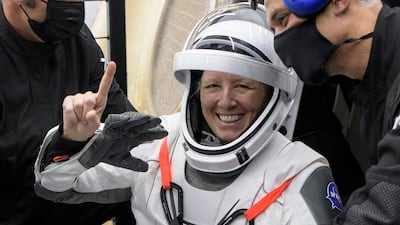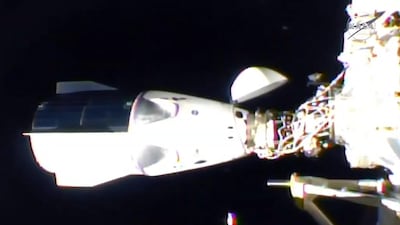SpaceX, the rocket company headed by entrepreneur Elon Musk, launched four astronauts on a flight to the International Space Station on Sunday.
It was Nasa's first full-fledged mission sending a crew into orbit aboard a privately owned spacecraft.
SpaceX's newly designed Crew Dragon capsule lifted off on top of a SpaceX Falcon 9 rocket at 7.27pm from Nasa's Kennedy Space Centre in Cape Canaveral, Florida.
The Falcon rocket thundered into the night with three Americans and one Japanese astronaut on board, the second crew to be launched by SpaceX.
The Dragon capsule, named Resilience by its crew owing to this year's many challenges, most notably the Covid-19 pandemic, was due to reach the space station late on Monday and remain there until the spring.
SpaceX founder and chief executive Elon Musk was forced to monitor the action from afar because he suspects he is infected with Covid-19.
He tweeted that he “most likely” had a moderate case of the disease Covid-19.
Nasa policy at Kennedy Space Centre requires anyone who tests positive for coronavirus to quarantine.
Sunday's launch came only a few months after SpaceX's two-pilot test flight. It begins what Nasa hopes will be a long series of crew rotations between the US and the space station, after years of delay.
More people means more science research at the orbiting lab, according to officials.
“This is another historic moment,” Nasa administrator Jim Bridenstine said last Friday.
“Make no mistake: vigilance is always required on every flight.”
The flight to the space station, which lasts 27.5 hours door to door, should be entirely automated, although the crew can take control if needed.
With Covid-19 still surging in the US, Nasa continued the safety precautions put in place for SpaceX’s crew launch in May.
The astronauts went into quarantine with their families in October. All launch personnel wore masks, and the number of guests at Kennedy Space Centre was limited. Even the two astronauts on the first SpaceX crew flight stayed behind at Johnson Space Centre in Houston, Texas.
US Vice President Mike Pence, chairman of the National Space Council, travelled from Washington to watch the launch.
The crew is about as diverse as they come and includes physicist Shannon Walker, Navy Cmdr Victor Glover, the first Black astronaut on a long-term space station mission, and Japan's Soichi Noguchi, who became the first person in almost 40 years to launch on three types of spacecraft.
They rode out to the launch pad in Teslas, built by another company run by Mr Musk, after exchanging high fives and other gestures with their children and spouses, who huddled at open car windows. SpaceX president Gwynne Shotwell bid the astronauts farewell in Mr Musk's absence.
The four astronauts will join two Russians and an American who flew to the space station last month from Kazakhstan.




































